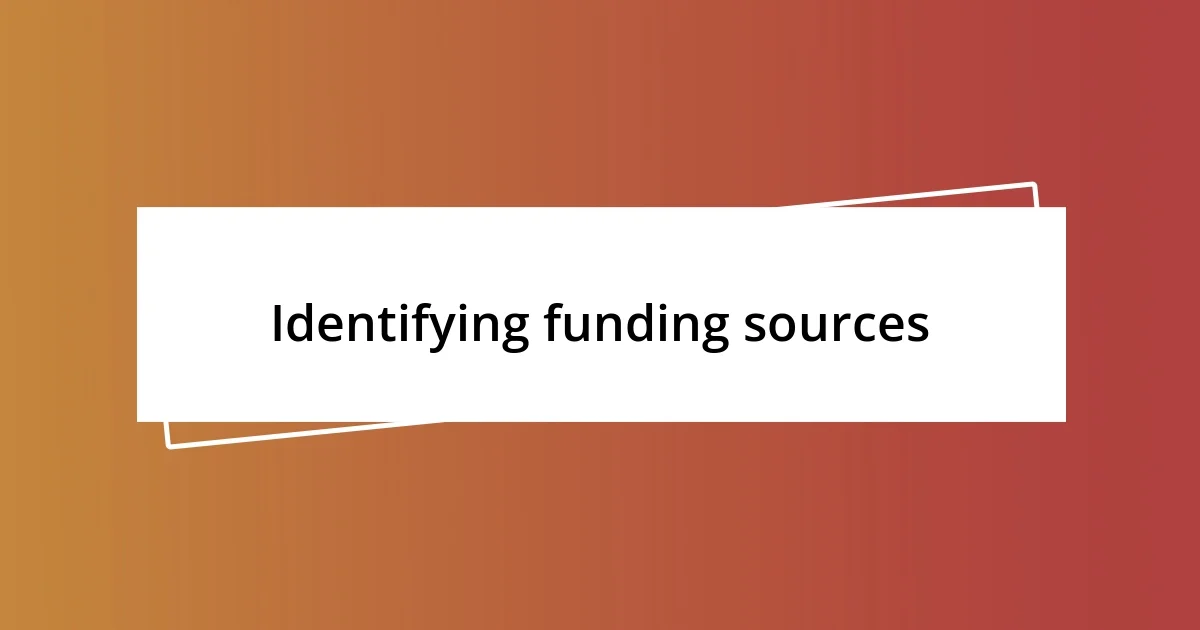Key takeaways:
- Recessions significantly impact financial security and emotional well-being, requiring individuals to adapt and reassess their financial strategies.
- Identifying alternative funding sources, such as crowdfunding, local grants, and strategic partnerships, can provide crucial support during economic downturns.
- Building a financial contingency plan and fostering a culture of innovation enhance resilience and adaptability, helping businesses navigate future challenges effectively.

Understanding recession impacts
Recessions can feel unsettling, like a heavy cloud hovering over our daily lives. I remember the palpable tension in the air during the last economic downturn; many of my friends faced layoffs, and even those with stable jobs experienced salary cuts. It really made me reflect on the fragility of financial security—something most of us take for granted until it’s threatened.
The impacts of a recession are not just about finances; they can seep into our emotional well-being and relationships. I found myself looking at my budget with a magnifying glass, questioning every expense. It made me realize how easy it is to get lost in self-doubt; I often asked myself, “What if this is the beginning of something worse?” Such uncertainty is not just scary; it’s a stark reminder of the economic cycles we all navigate.
Moreover, businesses often cut back on spending during tough times, which can lead to a ripple effect of reduced opportunities. I recall a small business owner in my community who decided to pivot to online sales just to stay afloat. This adaptability was inspiring, but it also highlighted the tough choices many have to make when facing a recession, slowly shaping their paths forward amidst uncertainty.

Identifying funding sources
Identifying funding sources during a recession can be daunting, especially as traditional channels often dry up. I remember scrambling to find creative and flexible funding options when my business was affected. It pushed me out of my comfort zone, and I had to think beyond conventional loans and grants. Exploring alternative avenues opened my eyes to unexpected opportunities.
Here are some potential funding sources I found helpful:
- Crowdfunding platforms: Websites like Kickstarter or GoFundMe can allow you to gain community support.
- Local grants: Municipalities sometimes have funds set aside for small businesses, especially during a recession.
- Angel investors: Individuals looking to invest in startups can provide significant backing, often more adaptable than traditional investors.
- Strategic partnerships: Collaborating with other businesses can lead to shared resources and funding.
- Government assistance programs: Keep an eye on initiatives aimed at aiding businesses during economic downturns.
Finding funding means getting creative and tapping into resources you might not immediately consider. Each of these options has its own set of rules and potential rewards, but they can be game-changers in tough times.

Evaluating loan options
When evaluating loan options during a recession, it’s crucial to consider not just the terms, like interest rates and repayment periods, but also the lender’s flexibility. I remember weighing my options carefully, realizing that a lender who offered a longer grace period could offer much-needed breathing room. It was a tense moment, balancing the risks of debt against the need to navigate through tough times.
Additionally, understanding the purpose and structure of the loans is vital. Fixed-rate loans might seem appealing for their predictability, yet I found variable rates could sometimes offer lower initial costs in a fluctuating market. This decision-making process can feel overwhelming, especially under financial pressure, but taking the time to analyze each option deeply can make a significant difference in the long run.
Ultimately, reaching out to different lenders and having candid discussions about their offerings allowed me to feel empowered in my decision-making. I appreciated lenders who were transparent, willing to explain their terms and conditions. This openness fostered a sense of trust that is incredibly valuable during uncertain economic times.
| Loan Type | Advantages |
|---|---|
| Fixed-Rate Loans | Stable payments and predictable costs. |
| Variable-Rate Loans | Often lower initial interest rates. |
| Government-backed Loans | Usually offer lower interest rates and flexible terms. |
| Peer-to-Peer Loans | Potential for better rates through direct connections. |

Leveraging grants and aid
Grants and aid can be a lifeline during tough financial times, especially when traditional funding appears out of reach. I vividly recall the moment I stumbled upon a local grant meant specifically for businesses adapting to economic challenges. There’s something almost exhilarating about finding money you don’t have to repay! Tapping into these resources not only eased my financial burden but also boosted my confidence in navigating that uncertain period.
In my experience, applying for grants requires more than just submitting paperwork; it’s about storytelling. I learned that articulating my business’s vision and how it aligned with the grant’s goals could set my application apart. Was my passion clear? Did it make an emotional connection? Those questions pushed me to infuse my application with genuine enthusiasm, which I believe resonated with the decision-makers. The process was daunting, but the potential rewards made the effort worthwhile.
Additionally, connecting with local nonprofit organizations that offered support was invaluable. I remember one meeting that felt like a genuine turning point; the insights I gained from other entrepreneurs made all the difference. It’s impressive what communities can do during hardships, right? Sharing resources and information about available aid not only helped me but also fostered a sense of camaraderie that transformed my outlook on the challenges we faced together.

Building a financial contingency plan
Building a financial contingency plan is one of the smartest moves I made during a recession. I started by creating a comprehensive budget that accounted for various scenarios, including unexpected drops in revenue. It was eye-opening to see how a simple spreadsheet could illuminate potential pitfalls; for example, a temporary dip in sales could quickly snowball into a significant cash flow issue if not prepared for. Have you ever laid out your finances to see what you’re truly working with? I found that facing the numbers head-on gave me control over my financial narrative.
Next, I prioritized building an emergency fund. Even if it felt far-fetched, I made it a mission to set aside a little from each paycheck. The goal was to have at least three months of operating expenses tucked away. This buffer created a sense of security—imagine the peace of mind that comes from knowing you can keep the lights on even when business gets tough. Could you imagine not stressing about paying your bills during a downturn? That financial cushion was more than just cash; it became my safety net.
Lastly, I scheduled regular reviews of my plan. Life changes, and so do finances, so why not reassess every few months? I remember one time when I discovered a bigger-than-expected expense looming on the horizon. That proactive approach meant I could adjust my strategy and tighten my budget before the impact hit. It’s a constant learning process, isn’t it? Developing a contingency plan isn’t just about having a backup; it’s about being forward-thinking and resilient, ready to face whatever challenges come your way.

Networking for investment opportunities
Networking for investment opportunities was a game-changer for me during the recession. At first, I felt like walking into those networking events was stepping into a lion’s den—intimidating and uncertain. But then I realized these gatherings were filled with people just like me, all eager to share ideas and resources. I remember one evening after a local chamber of commerce meeting, where I struck up a conversation with an investor. That single connection led to a crucial funding round for my business, illuminating the importance of showing up and being open to conversations.
Building genuine relationships has been paramount in my networking journey. There were times when I felt like my pitch wasn’t polished enough or my business plan wasn’t stellar. However, the key for me was vulnerability—sharing my struggles and showcasing my determination often attracted more interest than my credentials ever could. Have you experienced moments when being real has led to unexpected opportunities? I certainly have, and I can confidently say that potential investors are often more interested in the person behind the business than in the numbers alone.
Following up is another crucial aspect I learned while networking. I used to think that exchanging business cards was the end of the process, but now I understand it’s just the beginning. After one particularly fruitful conversation, I sent a personalized email the next day expressing my gratitude and recapping our discussion. That simple gesture not only kept the door open but also demonstrated my commitment to developing that relationship. How often do we submit to the busy pace of life and forget to nurture these connections? Taking that extra step has proven invaluable; it transformed a fleeting introduction into a lasting partnership.

Adapting strategies for future resilience
Creating a resilient business model means being adaptable to change. One approach I valued was diversifying revenue streams. I started exploring services that complemented my main offerings. For instance, instead of only providing one core product, I began to offer consulting services. This pivot not only provided additional income but also opened doors to new audiences. Have you ever thought about how a small change could lead to vast opportunities?
I also learned the importance of embracing technology. During the recession, I realized the value of online tools that could streamline operations and enhance customer engagement. I integrated software for project management and communication, which improved my team’s productivity remarkably. I still recall the relief when I noticed how these tools reduced the stress of daily tasks and allowed for smoother collaboration. Have you considered how tech can alleviate some of the burdens in your work?
Lastly, I made it a priority to foster a culture of innovation within my team. Encouraging open dialogue created an environment where ideas could flourish. I remember hosting brainstorming sessions where everyone could contribute, regardless of their role. This not only made everyone feel valued but also sparked creativity that led to fresh strategies. Isn’t it fascinating how collaborating with others can lead to thriving solutions? I found that nurturing a space for teamwork became a strength that fortified my business against future uncertainties.














